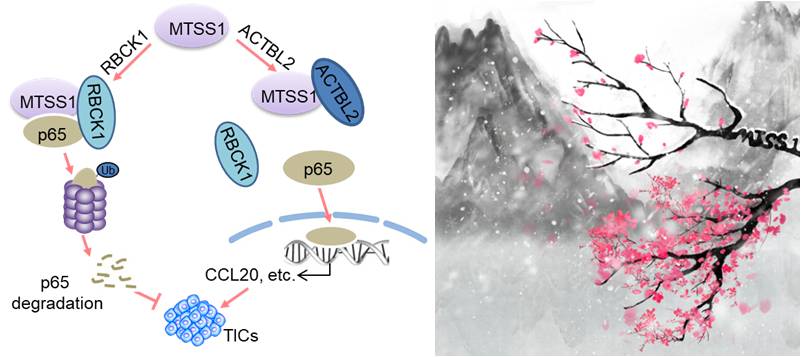
Tumor cells are characterized by high degree of heterogeneity and among them, tumor-initiating cells (TICs), sometimes also called cancer stem-like cells, are considered as the culprits of cancer development and progression, due to their enhanced tumorigenic capacity as compared to the non-TICs within tumors. Although targeted elimination of TICs is an appealing strategy in cancer therapeutics, current understanding of TIC regulation is largely incomplete, hindering the rational designing of TIC-targeting approaches.
Breast cancer is the most common female malignant tumor and seriously threatens women’s health. In a study published online in Nature Cancer, a research group led by Dr. HU Guohong from Shanghai Institute of Nutrition and Health (SINH) of the Chinese Academy of Sciences demonstrated that metastasis suppressor protein 1 (MTSS1), a scaffold protein, suppresses TICs of breast cancer by enhancing RBCK1-mediated p65 ubiquitination.
This study showed that Mtss1 knockout enhances the expansion and tumorigenicity of TIC subpopulation in both luminal and basal-like breast cancer mouse models, and the functional significance of MTSS1 is validated using patient-derived xenografts and organoids of breast cancer. MTSS1 was also found to suppress tumorsphere formation, migration and invasion of breast cancer cells, indicating that MTSS1 significantly suppressed breast cancer initiation and progression.
Mechanistically, MTSS1 interacts with the E3 ligase RanBP2-type and C3HC4-type zinc finger containing 1 (RBCK1) to facilitate RBCK1-mediated p65 ubiquitination and degradation, thus suppressing the NF-κB signaling pathway and tumorigenesis.In addition, the β actin-like protein ACTBL2 competes with RBCK1 for MTSS1 binding, leading to p65 stabilization and transcription of NF-κB target gene, promoting tumorigenesis.
This study revealed a new paradigm of NF-κB regulation and may have important implication in TIC-targeting therapeutics.

The function and mechanism of MTSS1 to regulate TICs in breast cancer. Left, a schematic model of the mechanism of MTSS1 to regulate TICs in breast cancer. Right, a Chinese ink wash painting of plum blossom, which symbolizes resilience and persistence in Chinese culture, resembles the preneoplastic lesions of mammary gland in the early stage of breast cancer initiation promoted by MTSS1 loss. Tumor initiating cells, regulated by MTSS1, also represent the most resilient population of tumor cells. (Image by Dr. HU Guohong’s group)

86-10-68597521 (day)
86-10-68597289 (night)

52 Sanlihe Rd., Xicheng District,
Beijing, China (100864)

